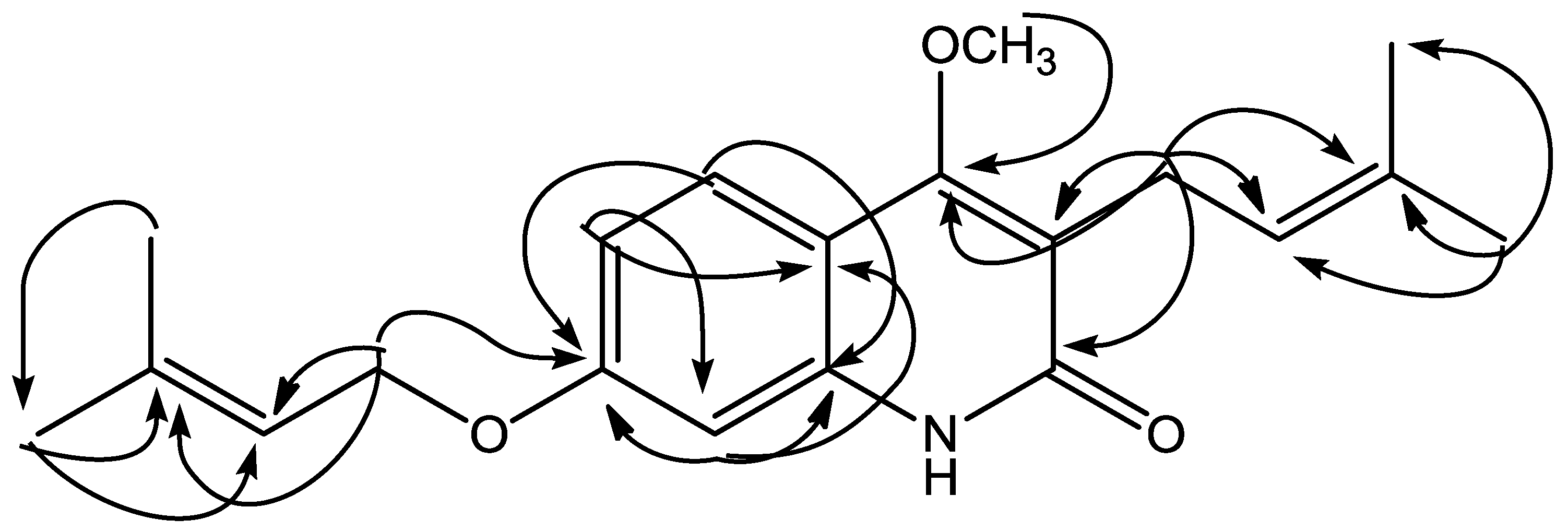4-Methoxy-3-(3-methylbut-2-en-1-yl)-7-[(3-methylbut-2-en-1-yl)oxy]quinolin-2(1H)-one from Melicope Moluccana T.G. Hartley
Abstract
:1. Introduction
2. Result and Discussion
3. Experimental Section
3.1. General
3.2. Plant Material
3.3. Extraction and Isolation
3.4. Cytotoxic Assay
3.5. Antiplasmodial Analysis
Supplementary Materials
Acknowledgments
Author Contributions
Conflicts of Interest
References
- Hartley, T.G. The genus Melicope (Rutaceae) in Borneo Sandakan. Sandakanian 1994, 47–74. [Google Scholar]
- Nakashima, K.; Oyama, M.; Ito, T.; Witono, J.R.; Darnaedi, D.; Tanaka, T.; Murata, T.; Iinuma, M. Melicodenines A and B, novel Diels-Alder type adduct isolated from Melicope denhamii. Tetrahedron. Lett. 2011, 52, 4694–4696. [Google Scholar] [CrossRef]
- Nakashima, K.; Oyama, M.; Ito, T.; Akao, Y.; Witono, J.R.; Darnaedi, D.; Tanaka, T.; Murata, T.; Iinuma, M. Novel quinolinone alkaloids bearing a lignoid moiety and related constituents in the leaves of Melicope denhamii. Tetrahedron 2012, 68, 2421–2428. [Google Scholar] [CrossRef]
- Sultana, N.; Hartley, T.G.; Waterman, P.G. Two novel prenylated flavanones from the aerial parts of Melicope micrococca. Phytochemistry 1999, 50, 1249–1253. [Google Scholar] [CrossRef]
- Chung, L.Y.; Yap, K.F.; Goh, S.H.; Mustafa, M.R.; Imiyabir, Z. Muscarinic receptor binding activity of polyoxygenated flavanones from Melicope subunifoliolata. Phytochemistry 2008, 69, 1548–1554. [Google Scholar] [CrossRef] [PubMed]
- O′Donnell, F.; Ramachandran, V.N.; Smyth, T.J.P.; Brooks, P. An investigation of bioactive phytochemicals in the leaves Melicope vitiflora by electrospray ionisation trap mass spectrometry. Anal. Chim. Acta 2009, 634, 115–120. [Google Scholar] [CrossRef] [PubMed]
- Simonsen, H.T. Four novel geminaly dialkylated, non-aromatic acetophenone derivatives from Melicope coodeana. Phytochem. Lett. 2012, 5, 371–375. [Google Scholar] [CrossRef]
- Kassim, N.K.; Rahmani, M.; Ismail, A.; Sukari, M.A.; Ee, G.C.L.; Nasir, N.M.; Awang, K. Antioxidant activity-guided separation of coumarins and lignan from Melicope glabra (Rutaceae). Food Chem. 2013, 139, 87–92. [Google Scholar] [CrossRef] [PubMed]
- Oyama, M.; Nakashima, K.; Kamiya, T.; Haba, M.; Ito, T. Flavonoids isolated from the leaves of Melicope triphylla and their extracellular-superoxide dismutase-inducing activity. Phytochem. Lett. 2013, 6, 215–218. [Google Scholar] [CrossRef]
- Komala, I.; Rahmani, M.; Sukari, M.A.; Ismail, H.B.M.; Ee, G.C.L.; Rahmat, A. Furoquinoline alkaloids from Melicope bonwickii (F.Muell) T. Hartley. Nat. Prod. Res. 2006, 4, 355–360. [Google Scholar] [CrossRef] [PubMed]
- Chen, J.-J.; Chang, Y.-L.; Teng, C.-M.; Su, C.-C.; Chen, I.-S. Quinoline alkaloids and anti-platelet aggregation constituents from the leaves of Melicope semecarpifolia. Planta Med. 2002, 68, 790–793. [Google Scholar]
- Chen, J.; Cho, J.; Hwang, T.; Chen, I. Benzoic acid derivatives, acetophenones, and anti-inflammatory constituents from Melicope semecarpifolia. J. Nat. Prod. 2008, 71, 71–75. [Google Scholar] [CrossRef] [PubMed]
- Tanjung, M.; Saputri, R.D.; Tjahjandarie, T.S. Antioxidant activity of two isomeric benzoxepin derivatives from the stem bark of Bauhinia acuelata L. J. Chem. Pharm. Res. 2014, 6, 705–708. [Google Scholar]
- Tanjung, M.; Tjahjandarie, T.S.; Sentosa, M.H. Antioxidant and cytotoxic agent from the rhizomes of Kaempferia pandurata. Asian Pac. J. Trop. Dis. 2013, 3, 401–404. [Google Scholar] [CrossRef]
- Tanjung, M.; Mujahidin, D.; Hakim, E.H.; Mujahidin, D.; Darmawan, A.; Syah, Y.M. Geranylated flavonols from Macaranga rhizinoides. Nat. Prod. Commun. 2012, 5, 1209–1211. [Google Scholar]
- Tjahjandarie, T.S.; Pudjiastuti, P.; Saputri, R.D.; Tanjung, M. Antimalaria and antioxidant activity of phenolic compounds isolated from Erythrina crysta-galli L. J. Chem. Pharm. Res. 2014, 6, 786–790. [Google Scholar]
- Tanjung, M.; Saputri, R.D.; Tjahjandarie, T.S. 5,9,11-Trihydroxy-2,2-dimethyl-10-(3′-methyl-2′-butenyl)-3-(2′′-methyl-3′′-butenyl)pyrano[2,3-a]xanthen-12(2H)-one from the stem bark of Calophyllum pseudomole. Molbank 2016, 3, M906. [Google Scholar] [CrossRef]


| No. C | δH (mult, J Hz) | δC | HMBC |
|---|---|---|---|
| 2 | - | 166.0 | - |
| 3 | - | 119.3 | - |
| 4 | - | 162.5 | - |
| 4a | - | 111.0 | - |
| 5 | 7.65 (d, 8.8) | 124.2 | C-7, C-8a |
| 6 | 6.83 (dd, 8.8; 2.4) | 112.4 | C-4a, C-8 |
| 7 | - | 160.6 | - |
| 8 | 6.79 (d, 2.4) | 98.8 | C-4a, C-7, C-8a |
| 8a | - | 139.1 | - |
| 1′ | 3.39 (d, 6.8) | 23.2 | C-2, C-3, C-4, C-2′, C-3′ |
| 2′ | 5.29 (t, 6.8) | 121.8 | C-4′, C-5′ |
| 3′ | - | 132.2 | - |
| 4′ | 1.83 (s) | 18.0 | C-2′, C-3′, C-5′ |
| 5′ | 1.79 (s) | 25.7 | C-2′, C-3′, C-4′ |
| 1′′ | 4.59 (d, 6.8) | 65.1 | C-7, C-2′′, C-3′′ |
| 2′′ | 5.52 (t, 6.8) | 118.9 | C-4′′, C-5′′ |
| 3′′ | - | 139.0 | - |
| 4′′ | 1.83 (s) | 18.3 | C-2′′, C-3′′, C-5′′ |
| 5′′ | 1.70 (s) | 25.9 | C-2′′, C-3′′, C-4′′ |
| 4-OCH3 | 3.93 (s) | 61.8 | C-4 |
| NH | 11.29 (s) | - | - |
| Compound | (IC50, μg/mL) | |
|---|---|---|
| Cytotoxic Activity (P-388 Cells) | Antiplasmodial | |
| 4-methoxy-3-(3-methylbut-2-en-1-yl)-7-[(3-methylbut-2-en-1-yl)oxy]quinolin-2(1H)-one (1) | 0.63 | 4.28 |
| Artonin E | 1.33 | |
| Chloroquine | 1.03 | |
© 2017 by the authors. Licensee MDPI, Basel, Switzerland. This article is an open access article distributed under the terms and conditions of the Creative Commons Attribution (CC BY) license (http://creativecommons.org/licenses/by/4.0/).
Share and Cite
Tanjung, M.; Saputri, R.D.; Wahjoedi, R.A.; Tjahjandarie, T.S. 4-Methoxy-3-(3-methylbut-2-en-1-yl)-7-[(3-methylbut-2-en-1-yl)oxy]quinolin-2(1H)-one from Melicope Moluccana T.G. Hartley. Molbank 2017, 2017, M939. https://doi.org/10.3390/M939
Tanjung M, Saputri RD, Wahjoedi RA, Tjahjandarie TS. 4-Methoxy-3-(3-methylbut-2-en-1-yl)-7-[(3-methylbut-2-en-1-yl)oxy]quinolin-2(1H)-one from Melicope Moluccana T.G. Hartley. Molbank. 2017; 2017(2):M939. https://doi.org/10.3390/M939
Chicago/Turabian StyleTanjung, Mulyadi, Ratih Dewi Saputri, Ryan Ayub Wahjoedi, and Tjitjik Srie Tjahjandarie. 2017. "4-Methoxy-3-(3-methylbut-2-en-1-yl)-7-[(3-methylbut-2-en-1-yl)oxy]quinolin-2(1H)-one from Melicope Moluccana T.G. Hartley" Molbank 2017, no. 2: M939. https://doi.org/10.3390/M939






